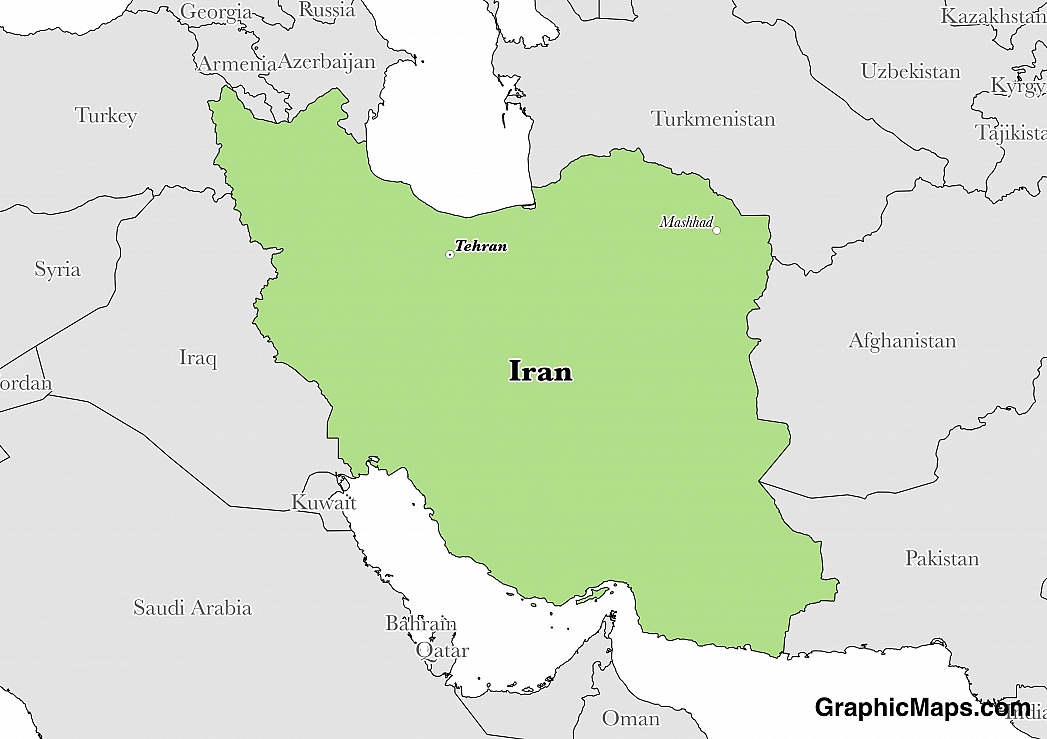Where is Iran?
Located in the Middle East, Iran has a 5,894.00 km border with Afghanistan (921 km), Armenia (44 km), Azerbaijan (689 km), Iraq (1,599 km), Pakistan (959 km), Turkey (534 km) and Turkmenistan (1,148 km). It has a 2.00 km coastline. Iran protests Afghanistan's limiting flow of dammed Helmand River tributaries.
Tehran, the capital city of Iran, has been the capital city of the country since 1796 when it was chosen by Agha Mohammad Khan from the Qajar Dynasty to become the central city of rule within the nation. Around 8.8 million people live in the city of Tehran, and 15 million live in the larger metropolitan area, Tehran is the most populous city in Iran as well as being the second-largest metropolitan area in the Middle East. An overwhelming majority of the population understand Persian although some of the people residing in Tehran speak it as a second language. The city has roots that can be traced back as far as 7,000 years, so there are many ancient cultural attractions in Tehran such as museums, government complexes, and unique architecture.
Read more on Iran's CapitalIran is an Asian country covering 1,648,195.00 km2 of which 7.07% is water and 1,531,595.00 km2 is land. This makes it the 17th largest country in the world and almost 2.5 times the size of Texas; slightly smaller than Alaska. Its geographic coordinates are 32 00 N, 53 00 E and Tehran is the capital city.
The name derives from the Avestan term "aryanam" which means "Land of the noble ones".
Its ISO code is IR.
Geography
Iran has a mean elevation of 1,305 m above sea level.
It has a arid and semiarid climate that is subtropical along the Caspian coast. Its terrain is mostly rugged, with deserts in the central basin.
Population
Iran has a population of 82,801,633 making it the 16th largest in the world. The majority of the population is found in the north, northwest, and west.
Persian is the official language. Major ethnic groups include Persian, Azeri, and Kurd. The official religion is Islam.
Since 1979, the official language of Iran has been Persian, ratified by the Constitution of the same year. Contemporary Persian is an evolution of Middle Persian which is a language rich in literary and cultural significance. Middle Persian broke the Arabic monopoly on writing in the region, and the language has had a significant impact on neighboring languages that have evolved since this time. There are 12 recognized Persian dialects in Iran, and they are all mutually-intelligible regarding speech and text. There are approximately 50 million Persian speakers in Iran and an estimated 110 million worldwide. In a country rich in cultural history such as Iran there are many minority languages spoken, some of which are incredibly ancient. The most widely spoken minority languages in the country are Azerbaijani and Kurdish which make up 14 and 7 percent of the population respectively. The minority languages in the country also include Arabic, Balochi, Gildaki, Mazandarani, and Tati among many others.
Read more on Iran's LanguagesThe dialing code for the country is 98.
Government
Iran is an independent country. The Islamic Republic of Iran was proclaimed in 1979. Its constitution was last ratified in 1979.
The current system of government in Iran can be described as a theocratic ruling structure at the national level as well as demonstrating democratic characteristics for local and Presidential elections. Although Iran has an elected President, this individual will report to an indirectly elected Supreme Leader or Ayatollah. The legislative arm of the government is located in downtown Tehran, and 207 constituencies are represented in the 290 seats in this parliament. The President of Iran`s official residence is located in the Sa`dabad Complex which is also in Tehran.
Read more on Iran's GovernmentEconomy
Factoring in Purchasing Power Parity, Iran's GDP is $1,460,000,000,000.00 (USD) with $18,100.00 (USD) per capita. This makes it the 18th largest economy and its citizens the 88th richest in the world. The currency of Iran is the Rial (IRR).
Its major export partners are China, India, and Turkey. Its main exports are petroleum, chemical and petrochemcial products, fruits and nuts, and carpets. Its major import partners are the United Arab Emirates, China, and South Korea. Its major imports include industrial supplies, capital goods, foodstuffs and other consumer goods.
Flag
The modern flag of Iran was officially adopted on 29 July 1980 as a way to symbolize the Islamic Revolution in the country the previous year. The flag consists of three identically sized horizontal stripes in green, white, and red which all have an important meaning within the Iranian and Persian culture. The national emblem of the country, designed in 1980 by Hamid Nadimi and located in the center of the flag, became an official symbol of the government once this flag was adopted. The Takbir, a common phrase in Islam, is imprinted 11 times along the bottom edge of the green stripe and 11 times along the top edge of the red stripe, reaffirming the importance of the Islamic faith to many in the country.
Read more on Iran's FlagThis page was last modified on January 17th, 2018
More on Graphicmaps

Published on 2019-11-06
What is a Trade Embargo?

Published on 2019-11-04
Which Two Countries Used to Have the Same Flag?

Published on 2019-09-16
What Is the Only Two-Sided State Flag?

Published on 2019-09-16
Which Country Flag Looks Like the Texas Flag?

Published on 2019-08-29
Flags That Resemble the US Flag

Published on 2019-08-20
